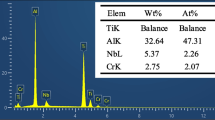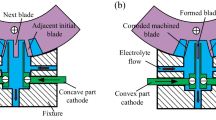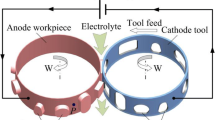Abstract
Counter-rotating electrochemical machining (CRECM) is a novel shaping method with advantages in processing revolving parts, especially engine casings. However, few researchers have studied the anodic behaviour of the counter-rotating state. This paper aims to analyse the anode dissolution behaviour of TA15 and obtain desired surface qualities in CRECM. The anodic characteristics were measured by polarization and cyclic voltammetry curves, and the passive-trans passive behaviour of TA15 was revealed. The electrode surface structures at different stages were analysed using electrochemical impedance spectroscopy (EIS), and a quantitative dissolution model was established to illustrate the electrochemical dissolution and structural evolution of the revolving surfaces. A series of CRECM experiments were conducted, and three stages (pitting corrosion, pitting expansion, and smoothing) were detected according to the current signals. In the first stage, an oxide film with small pores was formed initially on the metal surface when exposed to air. This air-formed oxide film was broken down locally during the electrochemical reaction process, resulting in the occurrence of pitting. With the increase of electricity, the oxide layer became thinner, and the pitting areas expanded and began to connect with each other. In this stage, the surface quality was poor owing to the uneven material dissolution. When the amount of electricity approximately reached a constant, the oxide layer was completely removed, and a very thin salt film was generated at the metal-electrolyte interface. In this stage, the material was dissolved uniformly, and the surface was smooth without pitting corrosion. Based on the obtained results, anode workpieces with grid-like convex structures were fabricated using CRECM. Both the revolving surface and the sidewalls of the convex structures can be controlled from pitting to smoothness.
Similar content being viewed by others
References
Arrazola P J, Garay A, Iriarte L M, et al. Machinability of titanium alloys (Ti6Al4V and Ti555.3). J Mater Processing Tech, 2009, 209: 2223–2230
Wang X, Gao P, Zhan M, et al. Development of microstructural in-homogeneity in multi-pass flow forming of TA15 alloy cylindrical parts. Chin J Aeronautics, 2019, 33: 2088–2097
Zhu D, Wang K, Yang J M. Design of electrode profile in electrochemical manufacturing process. CIRP Ann, 2003, 52: 169–172
Weinmann M, Stolpe M, Weber O, et al. Electrochemical dissolution behaviour of Ti90Al6V4 and Ti60Al40 used for ECM applications. J Solid State Electrochem, 2015, 19: 485–495
Wang Y, Xu Z, Zhang A. Anodic characteristics and electrochemical machining of two typical γ-TiAl alloys and its quantitative dissolution model in NaNO3 solution. Electrochim Acta, 2020, 331: 135429
Liu W, Ao S, Li Y, et al. Effect of anodic behavior on electrochemical machining of TB6 titanium alloy. Electrochim Acta, 2017, 233: 190–200
Mitchell-Smith J, Clare A T. Electrochemical jet machining of titanium: Overcoming passivation layers with ultrasonic assistance. Procedia CIRP, 2016, 42: 379–383
Pattavanitch J, Hinduja S. Machining of turbulated cooling channel holes in turbine blades. CIRP Ann, 2012, 61: 199–202
Xu Z, Wang Y. Electrochemical machining of complex components of aero-engines: Developments, trends, and technological advances. Chin J Aeronau, 2019, 34: 28–53
Lee S H, Townley D W, Eshun K O. A boundary element model of cathodic well casing protection. J Comput Phys, 1993, 107: 338–347
Wang D, Zhu Z, He B, et al. Counter-rotating electrochemical machining of a combustor casing part using a frustum cone-like cathode tool. J Manufact Processes, 2018, 35: 614–623
Cao W, Wang D, Zhu D. Modeling and experimental validation of interelectrode gap in counter-rotating electrochemical machining. Int J Mech Sci, 2020, 187: 105920
Wu Z, Wu X, Lei J, et al. Vibration-assisted micro-ECM combined with polishing to machine 3D microcavities by using an electrolyte with suspended B4C particles. J Mater Process Tech, 2018, 255: 275–284
Klocke F, Klink A, Veselovac D, et al. Turbomachinery component manufacture by application of electrochemical, electro-physical and photonic processes. CIRP Ann, 2014, 63: 703–726
Liu Y, Qu N S. Improvements to machining surface quality by controlling the flow direction of electrolyte during electrochemical sinking and milling of titanium alloy. Sci China Tech Sci, 2020, 63: 2698–2708
Fushimi K, Kondo H, Konno H. Anodic dissolution of titanium in chloride-containing ethylene glycol solution. Electrochim Acta, 2009, 55: 258–264
Liu Y, Qu N. Obtaining high surface quality in electrolyte jet machining TB6 titanium alloy via enhanced product transport. J Mater Process Tech, 2020, 276: 116381
Wang D, Zhu Z, Wang N, et al. Investigation of the electrochemical dissolution behavior of Inconel 718 and 304 stainless steel at low current density in NaNO3 solution. Electrochim Acta, 2015, 156: 301–307
González J E G, Mirza-Rosca J C. Study of the corrosion behavior of titanium and some of its alloys for biomedical and dental implant applications. J Electroanal Chem, 1999, 471: 109–115
Gao C, Qu N, Ding B, et al. An insight into cathodic reactions during wire electrochemical micromachining in aqueous hydrochloric acid solution. Electrochim Acta, 2019, 295: 67–74
Zhang B, Wang J, Wu B, et al. Unmasking chloride attack on the passive film of metals. Nat Commun, 2018, 9: 2559
Pan J, Thierry D, Leygraf C. Electrochemical impedance spectroscopy study of the passive oxide film on titanium for implant application. Electrochim Acta, 1996, 41: 1143–1153
Lohrengel M M, Rataj K P, Münninghoff T. Electrochemical machining—mechanisms of anodic dissolution. Electrochim Acta, 2016, 201: 348–353
Author information
Authors and Affiliations
Corresponding author
Additional information
This work was supported by the National Natural Science Foundation of China (Grant No. 51805259), the National Natural Science Foundation of China for Creative Research Groups (Grant No. 51921003), the China Postdoctoral Science Foundation (Grant No. 2019M661833), and the Postgraduate Research & Practice Innovation Program of Jiangsu Province (Grant No. KYCX21_0192).
Rights and permissions
About this article
Cite this article
Cao, W., Wang, D., Cui, G. et al. Anodic dissolution mechanism of TA15 titanium alloy during counter-rotating electrochemical machining. Sci. China Technol. Sci. 65, 1253–1262 (2022). https://doi.org/10.1007/s11431-021-1999-7
Received:
Accepted:
Published:
Issue Date:
DOI: https://doi.org/10.1007/s11431-021-1999-7




